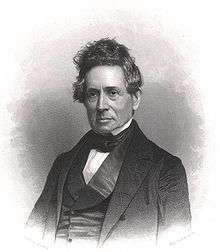Denison Olmsted
| Denison Olmsted | |
|---|---|
 | |
| Born |
June 18, 1791 East Hartford, Connecticut |
| Died |
May 13, 1859 (aged 67) New Haven, Connecticut |
| Institutions |
University of North Carolina at Chapel Hill Yale College |
| Alma mater | Yale College |
|
Signature | |
Denison Olmsted (June 18, 1791 – May 13, 1859) was an American physicist and astronomer.[1] Professor Olmsted is credited with giving birth to meteor science after the 1833 Leonid meteor shower over North America spurred him to study this phenomenon.
Biography
Olmstead was born June 18, 1791 in East Hartford, Connecticut. In 1813, he graduated from Yale College, where he acted as college tutor from 1815 to 1817. In the latter year, he was appointed to the chair of chemistry, mineralogy and geology in the University of North Carolina at Chapel Hill.[1] Here he proposed and executed the first state geological survey that was ever attempted in the United States, publishing reports of his work in 1824 and 1825. Although the state authorized the execution of the survey, Olmsted received no compensation for his services.
In 1825, he became professor of mathematics and physics at Yale. He published an elaborate theory of hail-stones in 1830, which caused much discussion, but finally received the general approbation of meteorologists. The shower of shooting stars that fell in November 1833 attracted his attention, and he studied their history and behavior until he was able satisfactorily to demonstrate their cosmical origin. Olmsted and his associate, Elias Loomis, were in 1835 the first American investigators to observe the Halley's Comet.[2]
In 1836, his Yale professorship was divided, and he retained that of astronomy and natural philosophy,[1] the department of mathematics being assigned to Anthony D. Stanley. For several years, he carried on a series of observations of the aurora borealis.
Olmsted possessed considerable mechanical talent, which he used in promoting and perfecting the inventions of others, but while he himself frequently invented articles of convenience and comfort, such as the Olmsted stove, he seldom secured his rights by patents.
He died at New Haven, Connecticut, on the 13 May 1859.[1]
Selected writings
His first publication (1824–1825) was the Report of his geological survey of the state of North Carolina. It was followed by various text-books on natural philosophy and astronomy, but he is chiefly known to the scientific world for his observations on hail (1830), meteors and the aurora borealis (see Smithsonian Contributions, vol. viii, Washington, 1850).[1] Others:
- Student's Commonplace Books (New Haven, 1828)
- Introduction to Natural Philosophy (2 vols., New York, 1831)
- Compendium of Natural Philosophy (1832)
- Observations on the Meteors of November 13th, 1833 (1834)[3]
- Introduction to Astronomy (1839)
- Compendium of Astronomy (1841)
- Letters on Astronomy, Addressed to a Lady (1841)
- Life and Writings of Ebenezer Porter Mason (New York, 1842)
- Rudiments of Natural Philosophy and Astronomy (Cincinnati, 1844)
Further reading
- Treadwell, Theodore R. (1946). "Denison Olmsted an Early American Astronomer". Popular Astronomy. 54: 237–241. Bibcode:1946PA.....54..237T.
- Parker, John M., III (2004). "Denison Olmsted, 18 June 1791-13 May 1859". Documenting the American South. University of North Carolina. Retrieved 2009-10-21.
Family
His son Francis Allyn Olmsted wrote a book on Hawaii. His son Alexander Fisher Olmsted (1822–1853) was a professor of chemistry at the University of North Carolina.
Notes
- 1 2 3 4 5
 One or more of the preceding sentences incorporates text from a publication now in the public domain: Chisholm, Hugh, ed. (1911). "Olmsted, Denison". Encyclopædia Britannica. 20 (11th ed.). Cambridge University Press. p. 90.
One or more of the preceding sentences incorporates text from a publication now in the public domain: Chisholm, Hugh, ed. (1911). "Olmsted, Denison". Encyclopædia Britannica. 20 (11th ed.). Cambridge University Press. p. 90. - ↑ Sisser, Sasha (6 May 2004). "Denison Olmsted (1791-1859)" (PDF). Temple University. Retrieved 16 November 2015.
- ↑ Olmsted, Denison (1833). "Observations on the Meteors of November 13th, 1833". The American journal of science and arts. 25: 363–411. Retrieved 3 April 2012.
References
 "Olmsted, Denison". Appletons' Cyclopædia of American Biography. 1900.
"Olmsted, Denison". Appletons' Cyclopædia of American Biography. 1900. This article incorporates text from a publication now in the public domain: Gilman, D. C.; Thurston, H. T.; Colby, F. M., eds. (1905). "article name needed". New International Encyclopedia (1st ed.). New York: Dodd, Mead.
This article incorporates text from a publication now in the public domain: Gilman, D. C.; Thurston, H. T.; Colby, F. M., eds. (1905). "article name needed". New International Encyclopedia (1st ed.). New York: Dodd, Mead.
External links
 "Olmsted, Denison". The American Cyclopædia. 1879.
"Olmsted, Denison". The American Cyclopædia. 1879.
- Works by Denison Olmsted at Project Gutenberg
- Works by or about Denison Olmsted at Internet Archive